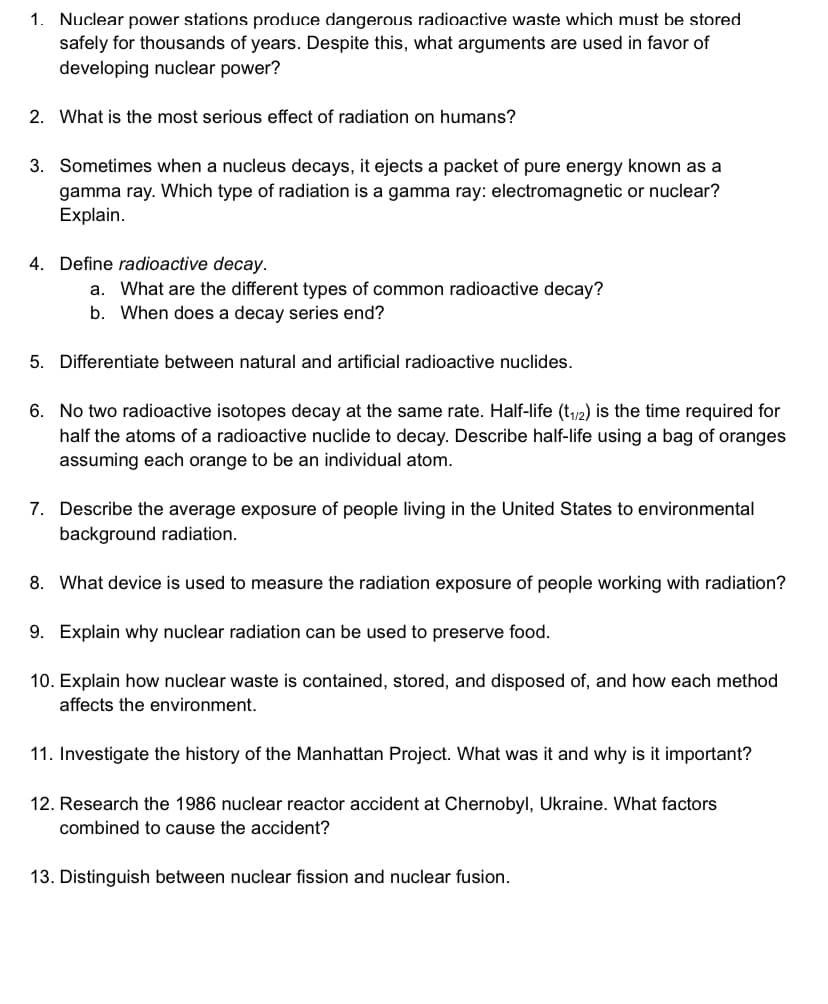Nuclear power stations produce dangerous radioactive waste which must be stored safely for thousands of years. Despite this, what arguments are used in favor of developing nuclear power?
Nuclear power stations produce dangerous radioactive waste which must be stored safely for thousands of years. Despite this, what arguments are used in favor of developing nuclear power?
Chemistry for Engineering Students
4th Edition
ISBN:9781337398909
Author:Lawrence S. Brown, Tom Holme
Publisher:Lawrence S. Brown, Tom Holme
Chapter14: Nuclear Chemistry
Section: Chapter Questions
Problem 14.96PAE
Related questions
Question

Transcribed Image Text:1. Nuclear power stations produce dangerous radioactive waste which must be stored
safely for thousands of years. Despite this, what arguments are used in favor of
developing nuclear power?
2. What is the most serious effect of radiation on humans?
3. Sometimes when a nucleus decays, it ejects a packet of pure energy known as a
gamma ray. Which type of radiation is a gamma ray: electromagnetic or nuclear?
Explain.
4. Define radioactive decay.
a. What are the different types of common radioactive decay?
b. When does a decay series end?
5. Differentiate between natural and artificial radioactive nuclides.
6. No two radioactive isotopes decay at the same rate. Half-life (t₁/2) is the time required for
half the atoms of a radioactive nuclide to decay. Describe half-life using a bag of oranges
assuming each orange to be an individual atom.
7. Describe the average exposure of people living in the United States to environmental
background radiation.
8. What device is used to measure the radiation exposure of people working with radiation?
9. Explain why nuclear radiation can be used to preserve food.
10. Explain how nuclear waste is contained, stored, and disposed of, and how each method
affects the environment.
11. Investigate the history of the Manhattan Project. What was it and why is it important?
12. Research the 1986 nuclear reactor accident at Chernobyl, Ukraine. What factors
combined to cause the accident?
13. Distinguish between nuclear fission and nuclear fusion.
Expert Solution
This question has been solved!
Explore an expertly crafted, step-by-step solution for a thorough understanding of key concepts.
This is a popular solution!
Trending now
This is a popular solution!
Step by step
Solved in 2 steps with 2 images

Knowledge Booster
Learn more about
Need a deep-dive on the concept behind this application? Look no further. Learn more about this topic, chemistry and related others by exploring similar questions and additional content below.Recommended textbooks for you

Chemistry for Engineering Students
Chemistry
ISBN:
9781337398909
Author:
Lawrence S. Brown, Tom Holme
Publisher:
Cengage Learning

Chemistry: Principles and Practice
Chemistry
ISBN:
9780534420123
Author:
Daniel L. Reger, Scott R. Goode, David W. Ball, Edward Mercer
Publisher:
Cengage Learning


Chemistry for Engineering Students
Chemistry
ISBN:
9781337398909
Author:
Lawrence S. Brown, Tom Holme
Publisher:
Cengage Learning

Chemistry: Principles and Practice
Chemistry
ISBN:
9780534420123
Author:
Daniel L. Reger, Scott R. Goode, David W. Ball, Edward Mercer
Publisher:
Cengage Learning



Chemistry
Chemistry
ISBN:
9781305957404
Author:
Steven S. Zumdahl, Susan A. Zumdahl, Donald J. DeCoste
Publisher:
Cengage Learning

Chemistry: An Atoms First Approach
Chemistry
ISBN:
9781305079243
Author:
Steven S. Zumdahl, Susan A. Zumdahl
Publisher:
Cengage Learning